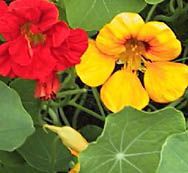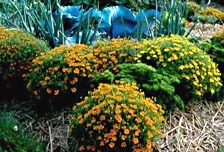Edible flowers are used as attractive garnishes in upscale restaurants. They’re prettier than parsley, but unlike parsley, a lot of people are timid about actually eating them. But they are good to eat!
Flower garnishes turn ordinary dinners into something special – their colors are attractive and they add zesty flavors to many dishes.
Grow your own edible flowers

Nasturtiums – peppery flavor
Edible flowers are as beautiful in the garden as they are tasty in the kitchen.
These dual-purpose plants are attractive in most styles of flower garden, and you can use them to pretty up your vegetable patch too.
Edible flowers are expensive to buy because they’re fragile and need to be used soon after picking. So if you want to garnish salad with nasturtiums or guacamole with cilantro flowers, the solution is to grow your own.
Remember: eat flowers only if they’re grown organically, yet another reason to grow them yourself.
Popular edible flowers you can grow
Nasturtiums are the most common edible flower. Their bold yellow or scarlet colors make them a great addition to green salads. Nasturtiums also come in orange, pale orange, cream and bicolors, and they’re easy to grow from seed or purchased transplants. As for the flavor: at first the taste is sweet, but that’s followed by a bold peppery tang.
You can make flavorful vinegar from nasturtiums by adding the flowers to good-quality white wine vinegar. Let the mixture rest in a dark, cool cupboard or the refrigerator (light will fade the color) for several weeks, then strain the flowers out and decant the vinegar into a clean glass bottle.
Pansies are a favorite annual. They come in many colors and have a delicate fragrance. The flavor is that of mild wintergreen. You can make an elegant appetizer with flavored cream cheese on a cracker topped with a pansy flower. Pansies also make terrific cake decorations.
Calendula, also known as pot marigold, was once known as poor man’s saffron because the yellow or orange petals of these daisy-like flowers can substituted for saffron. To get the effect, cook them with oil to bring out the color and flavor. Sauté some chopped onions in a bit of olive oil, add calendula petals, rice, and boiling water or broth. The result is a beautiful side dish that looks like Spanish paella.
Calendula petals also add pizzazz to carrot cake when they are sprinkled over the cream cheese icing.
Squash flowers are edible too. Acorn, patty pan squash and zucchini flowers all make terrific edibles. Traditional in Mediterranean cuisine, squash blossoms are usually stuffed with flavored breadcrumbs or ricotta cheese and sautéed or fried. The flowers have a mild flavor similar to zucchini or yellow squash. Pumpkin and gourd flowers are also edible.
Zucchini seems to grow to baseball bat sizes overnight. Eating the flowers has a birth control effect: the more flowers you eat, the less zucchini you have to deal with!

Tangerine and lemon gem marigolds have citrus-like flavor
Gem marigold varieties such as ‘Lemon Gem’ and ‘Tangerine Gem’ are favorite annuals for prettying up the vegetable garden. This marigold (Tagetes tenuifolia) with its fernlike foliage is the only edible variety.
Gem marigolds have a citrus-tarragon flavor and a lemony scent. When you pull the petals from the flower, break off the right-angled portion, as it can be bitter. Gem marigolds add flavor to deviled eggs.
Edible flowers from herbs
Most herb flowers are delicious to eat. Their flavor is often milder and sweeter than that of the leaves. You can eat the flowers of dill, fennel, arugula, basil, chives, cilantro and garlic chives.
There’s nothing like herb flowers and freshly chopped herbs to turn an everyday potato salad into something special. More herb growing tips.




